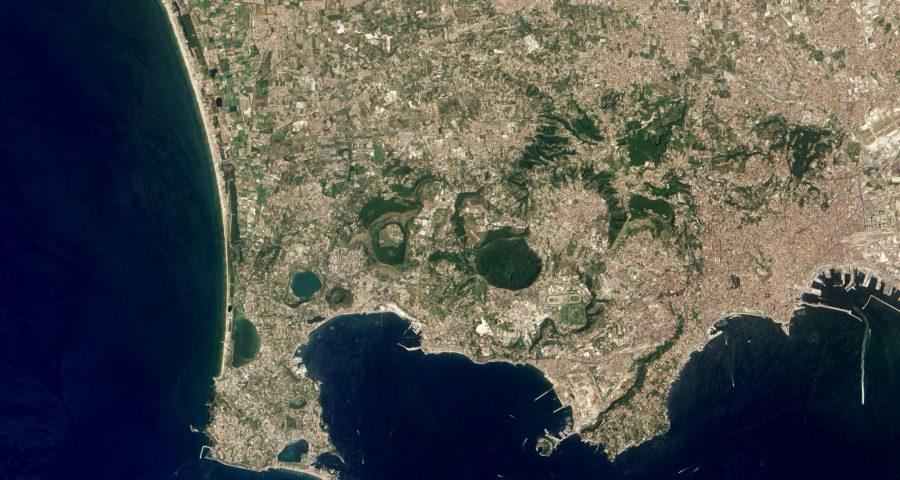In a groundbreaking development that could reshape our understanding of volcanic risk management, scientists have unveiled critical insights into the Campi Flegrei caldera, a vast volcanic region in Italy known for its seismic activity. Recent research, highlighted by the online science news platform Phys.org, offers promising solutions for mitigating earthquake hazards in one of Europe’s most densely populated and geologically complex areas. With a history of violent eruptions and significant geological upheavals, Campi Flegrei poses a formidable challenge to scientists and authorities alike. This new study not only enhances our comprehension of the caldera’s behaviors but also lays the groundwork for innovative strategies aimed at reducing the risks associated with potential eruptions and seismic events. As Italy continues to grapple with its volcanic legacy, these findings hold significant implications for public safety and urban planning in the shadow of this powerful geological force.
Breakthrough Findings Enhance Earthquake Risk Management in Campi Flegrei Caldera
Recent research from a team of scientists has unveiled crucial insights that could significantly improve earthquake risk management in the Campi Flegrei caldera, a volcanic region in southern Italy known for its geological activity. By employing advanced monitoring techniques, including satellite-based radar and seismic data analysis, the researchers have pinpointed key geological features that could predict the likelihood and severity of earthquakes in this region. These findings suggest a need for an updated risk assessment strategy, which could be instrumental in safeguarding local populations and infrastructure.
The study highlights the importance of real-time monitoring and geological mapping to facilitate early warning systems. Among the critical factors identified are:
- Ground Deformation: Variations in the ground surface can indicate magma movement.
- Seismic Activity: Patterns of smaller quakes may forecast larger seismic events.
- Hydrological Changes: Shifts in groundwater levels can also signal volcanic unrest.
Optimizing these monitoring techniques will allow authorities to implement timely evacuation plans and public safety measures, ultimately reducing the impact of potential earthquakes on communities situated near this volatile caldera.
Innovative Strategies Laying Groundwork for Safer Urban Planning in Italy
Recent findings at Italy’s Campi Flegrei caldera suggest novel approaches that could significantly enhance urban planning safety in seismically active regions. As scientists work to better understand the volatile nature of this supervolcano, their research reveals critical data that can inform the design and location of infrastructure in nearby urban areas. Innovative strategies derived from these findings emphasize the integration of geological assessments into urban development initiatives, allowing planners to prioritize safer building practices. Key strategies include:
- Dynamic zoning regulations: Adapting land use policies based on real-time seismic data.
- Enhanced early warning systems: Implementing advanced technology that predicts geological activity.
- Community education programs: Ensuring local populations are informed about earthquake preparedness and safety measures.
Furthermore, collaboration between scientists, urban planners, and local governments is crucial for translating this research into actionable policies. Efforts are being made to create comprehensive risk assessment frameworks to evaluate potential hazards associated with seismic activity. By employing a multidisciplinary approach, cities like Naples can look to mitigate the impacts of future eruptions and earthquakes. An illustrative example of collaboration is seen in the development of a risk management table that outlines necessary interventions:
| Intervention | Description | Timeline |
|---|---|---|
| Seismic Reinforcement | Strengthening existing structures to withstand seismic activity. | 2024-2026 |
| Public Infrastructure Upgrade | Revamping bridges and roads to improve safety standards. | 2025-2027 |
| Community Drills | Regular earthquake preparedness drills for residents. | Ongoing |
Collaboration Between Scientists and Local Authorities Essential for Effective Mitigation
The recent breakthroughs in understanding the seismic risks associated with Italy’s Campi Flegrei caldera underscore the vital importance of cooperation between scientists and local authorities. Enhanced collaboration can facilitate the integration of scientific findings into actionable strategies that address public safety concerns. Specifically, establishing a framework where researchers and officials work side by side allows for the development of targeted risk communication, tailored response planning, and community engagement initiatives. This partnership is essential for ensuring that the scientific knowledge does not remain confined to academic circles but is translated into effective public policy.
Key areas of focus for this collaboration include:
- Data sharing: Continuous exchange of real-time geological data to monitor the caldera’s activities.
- Emergency preparedness: Joint development of evacuation protocols based on research findings.
- Public education: Initiatives to inform residents about risk factors and emergency procedures.
- Long-term planning: Integrating scientific insights into urban development plans to reduce vulnerability.
Moreover, as part of the collaborative effort, establishing regular workshops and forums will help bridge gaps in understanding between scientists and policy-makers. This vital two-way communication can foster a culture of resilience, equipping communities better to face seismic challenges posed by the Campi Flegrei caldera.
In Summary
the groundbreaking research surrounding Italy’s Campi Flegrei caldera marks a significant advancement in our understanding of volcanic systems and earthquake risks. By uncovering the intricate mechanisms that govern seismic activity in this complex region, scientists are not only enhancing predictive models but also paving the way for improved safety measures that could protect local communities. As researchers continue to delve deeper into the dynamics of the caldera, their findings underscore the importance of ongoing monitoring and preparedness in earthquake-prone regions worldwide. The knowledge gained from this study holds promise for mitigating future risks, ensuring the safety of residents living near one of Europe’s most geologically active areas. As developments unfold, the scientific community remains vigilant, armed with newfound insights that could transform the landscape of geohazards research.
